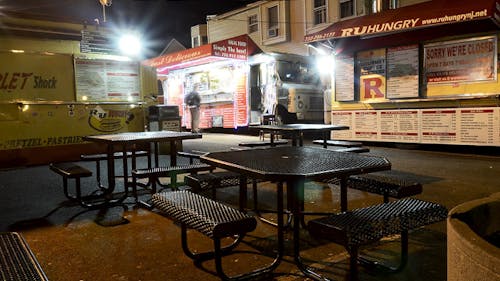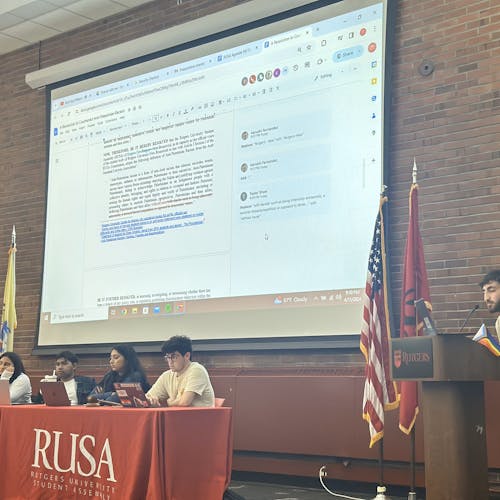Campus food vendors give range of choices

There are more than 20 eateries on campus that offer a wide range of foods, but finding a meal that is both healthy and inexpensive could prove difficult for some students.
Among food vendors on campus, those with higher fat and caloric content are generally cheaper than those with lower caloric content.
For example, an Au Bon Pain chicken cobb salad with avocado has 410 calories, 24 grams of fat and 10 grams of saturated fat, according to the restaurant’s website. With a small diet soda, the meal costs about $7.
The salad offers a healthy source of vitamin A and vitamin C, but is more expensive compared to the cheaper, high-fat Wendy’s “Everyday Value” meal which includes a Jr. Cheeseburger Deluxe, Value Fries, and a Value Pepsi. The meal would cost a student about $3, but consists of 700 calories, according to the restaurant’s website.
While men require 2,200 to 2,800 calories a day on average and women need 1,800 to 2,200 calories each day, according to the U.S. Department of Agriculture, students on campus must decide between low-priced, high-caloric foods and more expensive, healthier foods.
Students flock to the grease trucks on the College Avenue campus for fat sandwiches, which cost about $7 and can include chicken fingers, mozzarella sticks, french fries and marinara sauce, like in the “Fat Darrell” sandwich. The Tampa Bay Times reported in 2005 that the sandwhich made up 85 percent of a person’s daily caloric intake, at 1,718 calories.
But Ahmed Ahmed, the manager of RU Hungry, said the trucks offer more than just fat sandwiches.
“We have salads, we have soups, we have healthy stuff like veggie stuff,” Ahmed said.
At the Douglass Campus Center’s Douglass Café, students have access to a variety of healthy foods they can grab on the go, said Nick Kraus, the café’s concessions supervisor.
“We’ve brought in fresh fruit cups. … You can just grab one,” he said. “We have yogurt parfaits, as well as cheese and fruit [cups and] a wide variety of salads. We offer at our register … fresh fruit. We eliminated all the candy and other unhealthy foods.”
Peggy Policastro, a University Dining Services nutritionist, said the dining halls on campus offer an array of healthy options.
“Healthy beverages include filtered water, skim milk and 100-percent fruit juices,” she said. “Fresh whole fruits are available throughout the day and sliced fresh fruit is always available during the breakfast [and] brunch hours.”
All food items in the dining halls contain no trans fats listed on their nutrition facts label, Policastro said.
Joe Charette, the executive director of Dining Services, said with more than 5,000 food items on inventory, Dining Services has a vast number of options to choose from.
“If students use the dining hall ingredients like a pantry, the options are almost limitless,” he said.
Students can use grilled chicken breasts, which are available during lunch and dinner, for sandwiches, wraps, salads, pizza toppings or stir fry, Charette said.
When eating at the dining hall, it is up to the student to eat what they care to for an average cost of about $10 for meal plan holders, he said.
Students also have the option to eat at the food court in the student centers across the University, but Charette said the dining halls are a more cost-effective option.
“If you went into a student center for just a slice of pizza, for example, you can eat for less than it costs to enter a dining hall,” he said. “When you add, salad, soup, fruits and vegetables, drinks and dessert, it is always more economical to eat in the dining hall.”
Mario Hernandez, a School of Arts and Sciences sophomore, said it is easier to find unhealthy choices in the dining halls than healthier ones.
“I think there are healthy food options in the dining halls, but there isn’t as much variety in the healthy options as there are more unhealthy choices,” he said.
Camille Sennett, a School of Arts and Sciences junior, said the dining halls have healthy options, but those options are poorly placed.
“In the main lines, they place easy-to-cook, quickly served items, which tend to be unhealthy,” she said. “Students need to search for the healthier options, which may be problematic. … The dining halls focus on efficiency in serving, not nutrition.”
Another student said she does not think the University offers healthy affordable options for students to eat.
“Wendy’s is the cheapest [place to eat], which isn’t that healthy. I’m a commuter student, so I just bring my own lunch to school,” said Erin Hodgkiss, a School of Arts and Sciences sophomore.
Shane Whelan, a School of Arts and Sciences senior, believes there are healthy options that are also inexpensive.
“There are a lot of options,” Whelan said. “You [just] have to go out of your way to look for them [on campus].”



